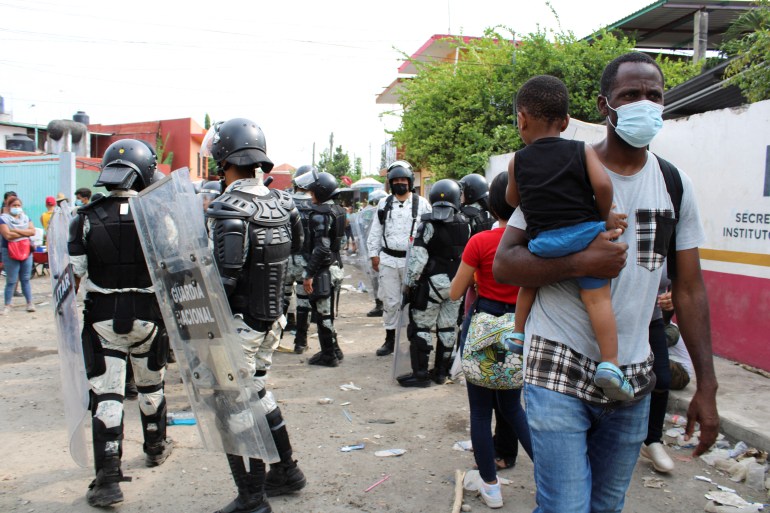US to end ‘Title 42’ border restriction in May: Reports
Biden administration expected to revoke contentious policy by May 23 but decision not yet finalised, AP and Reuters say.
US President Joe Biden’s administration is expected to lift a contentious border policy that prevents most asylum seekers from applying for protection in the United States, after calls to end “Title 42” have grown louder in recent weeks.
Citing unidentified sources, Reuters and The Associated Press reported on Wednesday that the administration would revoke the order by May 23 – though the news agencies said the decision has not been finalised.
Speaking to reporters on Wednesday, Biden said his administration would make a decision “soon”.
Title 42 was first invoked by Biden’s predecessor Donald Trump in March 2020, citing the need to prevent the spread of COVID-19.
But Biden has kept the order in place, despite widespread criticism and condemnation from rights groups, United Nations experts and others who say it violates international law and puts already vulnerable people at risk upon expulsion to Mexico or their home countries.
More than 1.7 million Title 42 expulsions have been carried out since the policy was enacted in 2020, according to US government data.

“We are near the next milestone of ending Title 42,” Marisa Limon-Garza, deputy director of Hope Border Institute, a group that works to help asylum seekers on the US-Mexico border, said in a statement.
“We have witnessed the hardship and trauma asylum seekers endured because of the prohibition to enter the US in an unjust way, allowed by Title 42,” she said. “This is the time to end the policy.”
Under Title 42, asylum seekers who arrive at US border crossings are sent back to Mexico or their country of origin within a few hours and are not given the chance to file asylum claims in the US.
Although the order came into effect as the country announced nationwide economic and travel closures linked to the coronavirus, immigrant rights advocates say it is not rooted in science and was used by Trump as a way to restrict the US asylum system.
Rights groups also say it has put asylum seekers in harm’s way. From the start of last year through mid-March, US-based group Human Rights First has documented nearly 10,000 reports of kidnapping, torture, rape, and other violent attacks against people sent to Mexico under Title 42.
The restriction also has become more difficult to defend on scientific grounds in recent months, as mask mandates were lifted and vaccination rates climbed across the US.

The Biden administration has defended its use of Title 42, however, saying it is a health rule that is based on guidance by the US Centers for Disease Control and Prevention (CDC), and not an immigration policy.
The CDC in late January extended Title 42 for two months, near the height of the Omicron variant’s spread in the US. The order is up for renewal this week, and an announcement is expected in the next few days.
The prospect of ending the policy raises the possibility that more asylum seekers and migrants would stream to the border, at a time when arrivals are already high.
The Department of Homeland Security (DHS) said on Tuesday that about 7,100 migrants were arriving daily, compared with an average of about 5,900 per day in February. This is on pace to match or exceed highs from last year, as well as in 2019 and other peak periods.
Reuters and AP said on Wednesday that the delayed effective date to end Title 42 would give US border authorities time to plan for its end.
White House communications director Kate Bedingfield said the Biden administration expects an influx of people at the border should Title 42 be lifted. She said it is planning for multiple contingencies, without specifying what those would be.
Later on Wednesday, DHS published a fact sheet detailing its preparations for a potential increase in migration at the border.
According to the document, the preparations include deploying more personnel and resources to address increased arrivals, expediting the asylum process, removing those whose claims fail and working with other countries in the western hemisphere to manage migration and address its “root causes”.




